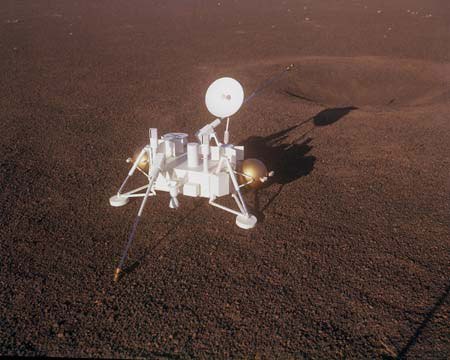Steven Lyle Jordan's Blog, page 21
August 21, 2016
Scales of science fiction “hardness”
 I recently came across a great article by M Alan that described science fiction in terms of levels of “hard” or “soft” applications of science and physics. It provides good descriptions of each level of the scale, and examples from SF movies, TV and books.
I recently came across a great article by M Alan that described science fiction in terms of levels of “hard” or “soft” applications of science and physics. It provides good descriptions of each level of the scale, and examples from SF movies, TV and books.
It was not only interesting reading, but fun to compare my novels to the scale to see where they landed (6.5 – 8.5, or hard to very hard… just so you know). It would’ve been nice if I’d had enough readers to apply a good storytelling rating to them as well, but 4- and 5-star ratings don’t mean much when your readership is in the low double-digits. Or single-digits. (Yeah, don’t get me started.)
Science fiction certainly isn’t alone when it comes to degrees of “hardness” or “softness”; in police dramas, for instance, I can point to, say, Law and Order on one end and TJ Hooker on the other. But SF seems to be much more severely judged by its fans based on where on the scale it falls. Its producers are similarly judged, an author or producer’s “worthiness” often directly attributed to their position on that scale. This is because SF tends to be tied more tightly to science (a concrete practice depending on real physics) than, say, police dramas are tied to accepted police procedures (which seem to be a lot like the Pirate’s Code… just a set of guidelines, really).
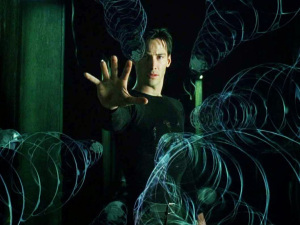 But there is more to science fiction than hardness or softness, as I was reminded the other day in watching the three Matrix movies. The Matrix, by the definitions in the article, probably falls at about 2/10 on the hardness scale… pretty low, just above comic books. But this doesn’t mean they are crappy movies; in fact, they are mind-bogglingly stylish, with great characterizations, imaginative worldbuilding and some inspired dialogue.
But there is more to science fiction than hardness or softness, as I was reminded the other day in watching the three Matrix movies. The Matrix, by the definitions in the article, probably falls at about 2/10 on the hardness scale… pretty low, just above comic books. But this doesn’t mean they are crappy movies; in fact, they are mind-bogglingly stylish, with great characterizations, imaginative worldbuilding and some inspired dialogue.
Great storytelling is much more than simply getting the science right: You have to communicate the story, the central idea, and communicate it well, or it doesn’t matter if you happen to know the atomic number of Einsteinium or the gravimetric well around Pluto. And if you do communicate it well, your audience will forgive things like using human beings on life-support to power mega-cities of machinery.
The list also served to remind me that, at least in today’s entertainment atmosphere, science fiction doesn’t do well if it’s too hard. Of most of the recent SF properties that have been popular hits, like Star Trek, Star Wars, Guardians of the Galaxy, The Matrix, Dr. Who, the Marvel superhero movies, The Fifth Element, Battlestar Galactica (2003)… none of these rated above 5.5/10 on the hard SF scale. Most of these rate below 4.5/10.
 The few properties that break that mold—for instance, Andy Weir’s The Martian, probably an 8.5-9/10 on the hardness scale—won over its readers through its publicizing of vetting and assistance from personnel at NASA, then by having Ridley Scott direct and Matt Damon (and a pretty strong supporting cast) star in the movie. In its case, star power beat hardness to make it a success. Of course, star power has played a significant part in making low-hardness SF incredibly successful in theaters… ask Robert Downey Jr, Chris Evans, Scarlett Johansson or Samuel L. Jackson.
The few properties that break that mold—for instance, Andy Weir’s The Martian, probably an 8.5-9/10 on the hardness scale—won over its readers through its publicizing of vetting and assistance from personnel at NASA, then by having Ridley Scott direct and Matt Damon (and a pretty strong supporting cast) star in the movie. In its case, star power beat hardness to make it a success. Of course, star power has played a significant part in making low-hardness SF incredibly successful in theaters… ask Robert Downey Jr, Chris Evans, Scarlett Johansson or Samuel L. Jackson.
And it also says something about my lack of traction in selling: My novels are too hard to make it on their own (that is, without something like The Martian‘s significant popular endorsement or advertisement to catch consumers’ attention). And sure enough, the books that were my most successful, the Kestral Voyages series, were the lowest on the hardness scale—about equal to Star Trek or Firefly. The message is clear: Science did not sell my books.
The obvious take-away from this is, if you want to be successful producing science fiction—and assuming one of your associates isn’t a major celebrity in the SF arena, or you’re not rich enough to buy heavy promotion—don’t make it hard. In fact, be as soft as possible without resorting to calling it outright fantasy. Put elements in your story, not based on realism, but based on their visceral excitement level… make them fun. Something for me to remember, if I ever lose my already-tenuous grip on sanity and try to get back into novel writing for fun and profit.
M Alan’s article is on Freehauler Alcione.


August 7, 2016
Wild Cards being developed for television
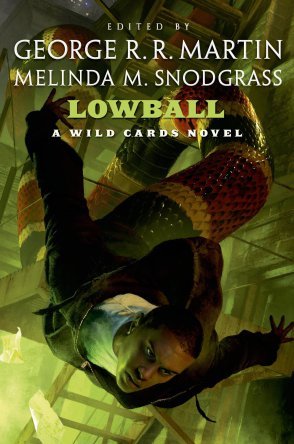 From his own blog (titled “Not a Blog”), George R. R. Martin reported that his incredible Wild Cards book series is under development by Universal Cable Productions (UCP), a division of NBC Universal, and a studio whose programs have been seen on USA, Bravo, E!, SyFy and Hulu.
From his own blog (titled “Not a Blog”), George R. R. Martin reported that his incredible Wild Cards book series is under development by Universal Cable Productions (UCP), a division of NBC Universal, and a studio whose programs have been seen on USA, Bravo, E!, SyFy and Hulu.
I was introduced to the books when they first came out in 1986, and was immediately hooked by a convincing world of superheroes and pulp adventures. I still read them voraciously today. Wild Cards was my standard to compare all other superhero fare. With programs like Heroes, Alphas and the various DC superheroes on TV, each was held up to the light against Wild Cards. And I’m here to tell you, none of them hold a candle to Wild Cards.
The Wild Cards series (in case you haven’t visited here before), is a reality that diverged from ours when alien scientists brought a human-mutating virus to Earth in 1946. Of those exposed to the virus, 90% died horribly, drawing the “black queen”; 9% were twisted and deformed into “jokers”; and a lucky 1% became blessed with extraordinary and unpredictable powers and became “aces.” This incredibly rich and imaginative world of superheroes and villains, monsters and disadvantaged jokers, has continued on to present day through (so far) twenty-two novels, comic books, graphic novels and role-playing games, reprinted in many languages and featuring some of the best science fiction and fantasy writers of the last thirty years.
UPC has an impressive list of programming, including Mr. Robot (a current favorite), Colony, Playing House, Royal Pains, and Suits on the USA Network; The Magicians, 12 Monkeys, and Killjoys on SyFy; Girlfriends’ Guide to Divorce on Bravo; The Royals on E!; Difficult People on Hulu; and Emmy winners Monk, Pysch, and Battlestar Galactica (another favorite). And they will be working closely with Melinda Snodgrass, one of the editors of Wild Cards since the first book. So they sound like they can turn out a quality product, I’d say.
Of course, “in development” doesn’t always translate to a TV series; but this is one to root for, as the series did more to “adult-ize” superhero content than any other novels, and all comics except Watchmen and Miracleman.
Read more about it on GRRM’s blog. And let’s hope this happens, people… it will be incredible.


July 30, 2016
Biometrics are needed for voting
 As we approach the 2016 American presidential election, a spectre from 2006 has started moaning in the background: The electronic voting machines that Diebold built for the U.S., which have turned out to be easily hackable, and have basically not been fixed since then. And there is legitimate concern that hackers may tamper with those electronic voting machines, and skew enough votes to throw such an expected-to-be-close presidential election.
As we approach the 2016 American presidential election, a spectre from 2006 has started moaning in the background: The electronic voting machines that Diebold built for the U.S., which have turned out to be easily hackable, and have basically not been fixed since then. And there is legitimate concern that hackers may tamper with those electronic voting machines, and skew enough votes to throw such an expected-to-be-close presidential election.
The problem is that the memory on those machines can easily by tapped into and individual votes can be manipulated in numerous ways. This is relatively easy because the machines store only the votes, not the info about who made them, in order to preserve the voters’ ability to cast a ballot anonymously. And not that there’s anything fundamentally wrong with that… but given the existing ease in corrupting electronic votes, anonymity at that voting booth has become a luxury the system can no longer afford.
I’ve argued before about the need to embrace biometric identification systems for daily security; and I’d say the American voting system is the most important example of a security point that needs it, to do no less than safeguard the democratic process of the nation.
It’s unfortunate that most Americans distrust biometric identification… not because it’s more secure, but because they are afraid their biometric IDs will somehow be hacked into by ne’er-do-wells. Some of this fear may be realistic, depending on how the biometric data is stored and applied at some points-of-sale. But much of it is a mostly media-fueled terror that thugs will be running around cutting off peoples’ fingers or plucking out their eyeballs to use at the ATM. (And yeah, ATM security cams will never notice that.)

Scanning the 3-D veins and blood flow in your hand is the future of biometric security.
But in fact, really secure systems can make biometric hacking virtually impossible (that is, too much trouble to make it worth anyone’s while to attempt). To begin with, the latest technology will recognize 3-D biometric info, making simple (and fake-able) surface scans useless; they can also tell the difference between live and dead body parts, and live voices as opposed to recordings. Verification points with this technology will be virtually impossible to spoof in realtime. Multiple-point verification is easier, and can be applied anywhere an extra level of security is needed. And if there is a discrepancy, transactions can be tagged to silently alert the authorities, or simply hold the transaction until it can be confirmed or cancelled later. For those who are afraid of being held hostage at an ATM until they deliver the goods, they will be able to carry out the transaction, then be released and cancel the transaction in a place of safety.
 We even have a more secure system than the electronic voting booth, ready for use: The cellphone. Cellphones already carry out verifiable transactions for us, which include transaction IDs, and can be set to send a verification signal to a second location to affirm or cancel transactions. Add biometric verification to phones, and you have a double-secure point from which you can register any vote, wherever you are, whenever it is convenient. Or it could be the verification point for electronic voting booths, helping to verify you are who you say you are when you vote.
We even have a more secure system than the electronic voting booth, ready for use: The cellphone. Cellphones already carry out verifiable transactions for us, which include transaction IDs, and can be set to send a verification signal to a second location to affirm or cancel transactions. Add biometric verification to phones, and you have a double-secure point from which you can register any vote, wherever you are, whenever it is convenient. Or it could be the verification point for electronic voting booths, helping to verify you are who you say you are when you vote.
With the development of quantum-level encoding, we can now guarantee a vote stays secure at every point in the voting process. And when the votes are tallied, the final numbers can be stored in a quantum-encrypted server, to be cross-verified at any time with the stored original votes in another server. All of this is do-able with the security and biometric technologies available to us today; it only requires our commitment to use them.
The use of security devices like biometrics tend to follow predictable patterns: Once invented, only a few willingly use them; followed by a significant and catastrophic loss of income or property, with seemingly no other way to protect yourself; followed by widespread adoption of said security device, with a few particularly paranoid holdouts; and finally, when the holdouts are given no other option, they adopt said security device (or go live in a survivalist camp in the mountains).
This is what I expect to be the adoption pattern with biometrics as well. The only question would be the catastrophic event that will cause us to commit to it… the loss of our money and property… or the election of a monster to the highest office in our land.
But if we have any sense, we’ll soon recognize the extent of the threat to our individual and collective livelihoods… the overreaction of our fears of security and personal violation… and the amount to which we’ll benefit from increased security… and finally bring forth a reliable, workable biometric ID system that will safeguard our lives and our nation.


July 28, 2016
New party politics
 2016 will certainly go down in U.S. history as having had one of the most tumultuous, frustrating and unnerving presidential contests in decades, featuring a party that stupidly backed into its own white supremacy rhetoric to nominate an unqualified, misogynistic, racist, failed billionaire… against a party that worked behind the scenes to block a reform candidate that had captured the hearts of the American youth, in favor of its pro-establishment known entity. And these are the two most prominent parties of the nation.
2016 will certainly go down in U.S. history as having had one of the most tumultuous, frustrating and unnerving presidential contests in decades, featuring a party that stupidly backed into its own white supremacy rhetoric to nominate an unqualified, misogynistic, racist, failed billionaire… against a party that worked behind the scenes to block a reform candidate that had captured the hearts of the American youth, in favor of its pro-establishment known entity. And these are the two most prominent parties of the nation.
As a result, a significant portion of the American public (the 58% portion that actually votes, at any rate) is actively looking for alternatives to the Democratic and Republicans, parties which seem to have lost touch with the pulse of the American public, not to mention a healthy dollop of reality. And I agree: It’s time for a shakeup to the two-party system (or, at the very least, these two parties).
America has had many political parties, but for over a century, they have been dominated by the Republican and Democrat parties. The two parties haven’t always stood for the things they stand for now, though the Republican party has always been considered the pro-business party, and the Democrats have always been considered the pro-equality party. Other parties have never been able to garner enough support to last; and as the country’s election process has come to be dominated by well-financed media (that is, well-financed by the Republicans and Democrats), the other parties have been relegated to the deep, dark shadows of popularity.
But with the emergence of social media, especially among the younger populations, those shadows have begun to lighten. We saw it in the last year with the rise of Bernie Sanders’ run for the Democratic nomination; and before that, the incredible surge of support through social media that helped enable Barack Obama to take the White House. And now, with so much dissatisfaction with the major parties, we have the chance to see other parties rise in prominence and popularity through the non-traditional media outlets.
In fact, there are a wealth of parties in the U.S., about 40 major and minor parties at last count. Are you surprised? That, in itself, is not surprising, as most of these parties are never mentioned in the popular media. But wikipedia lists them—many of them have a good social media presence—and as American citizens, it’s worth your time to investigate them.
What’s significant about the other parties is that they represent ideologies that aren’t necessarily drawn along the expected lines popularized (or maligned) by the Democrats and Republicans. Also, some of them place much different priorities on ideas that other parties might espouse. But some of them are very similar to the existing major parties, with only a difference in methodology to make them distinct.
In the past, since the rise of the Democratic and Republican parties, these differences have not been enough to create a significant votership; even the other major parties have voter roles at a fraction of those in the D and R camps. But now, with large groups of voters on both Democratic and Republican parties having publicly refused to vote for their party’s candidate, there’s a great opportunity for another party to step up and make inroads with those undeclared voters, perhaps to forge the first significantly large third party in over a century.
Possibly the most significant of these should, by all rights, be the Green party. The party, which is the country’s fourth-largest by membership, promotes environmentalism, nonviolence, social justice, participatory grassroots democracy, gender equality, LGBT rights and anti-racism. The Greens have had a sizable following for years, and when the well-known candidate Ralph Nader ran for the Greens, he secured enough popular votes to significantly deplete the voting numbers for Al Gore, effectively handing George W. Bush the presidency. (Thanks loads, Greens.)
The Green platform is similar enough to the Democratic platform that, when Bernie Sanders’ campaign was beginning to flag again Hillary Clinton’s state delegate wins, The Greens asked Sanders to run on their platform, but he declined to run Green. Now, after the reveal that the DNC actively blocked Sanders’ campaign run, 10% of “Bernie or Bust” Democrats have decided not to give their vote to Clinton, but instead to go Green and vote for candidate Jill Stein.
Unfortunately, with the present voter numbers, such a move will likely replicate the 2000 Bush vs. Gore elections, when Independent Party candidate Ralph Nader garnered enough votes—largely from Democratic voters—to cost Gore the election by a hair-thin margin. This time, that will mean putting Trump in the White House (now there’s something to look forward to—thanks again, Greens).
For this reason alone, I echo Sanders’ plea to his followers to avoid going Green, and to vote for Clinton, if for no other reason than to avoid another 2000 election and make sure Trump does not win the presidency.
That being said… now (or possibly just after the elections) is the moment for the Green party to step up and put its best foot forward. Stein and her followers are in a perfect position to reach out to America’s voters and bring them into their platform. Though their efforts cannot possibly bring Stein a win in 2016, the next election will be theirs to win or lose. As Obama showed America how to use social media to their advantage, the Greens can become a mighty presence in social media, using the next four years to build their party, reach out to the masses, and push beyond traditional media systems. When they become enough of a social media presence, they will see traditional media reach out to them, as traditional media has done with every significant (and many insignificant) social media movement.
In short, the Green party should be acting right now to get ready for 2020… a nice, round number for a historic election, no? And depending on how this election goes, America might be literally screaming for better party options in four years.
I suspect the Greens are in a better position to take advantage of it than any other party; they can already appeal to most of the Democratic base, if they can demonstrate that they have a better way. But this advice obviously applies to all minor political parties, not to mention any new parties that might try to make a splash. America has grown and developed a lot in 200 years, and it’s time to look at a new set of priorities for this country, such as preserving the environment of Spaceship Earth, ensuring equality and sustainability for all people, improving social services, putting science to work to improve our quality of life, acknowledging our changing biological diversity, and ensuring a better future for Mankind.
And as for the Democrats and Republicans? It might be time for one or both of them to accept the fact that they no longer represent the American people, but rule only because they carry the loudest voices. But thanks to social media, even the quietest voices can now be heard nationwide. We’ll soon see how that will change the American political landscape.


July 20, 2016
Why don’t we care?
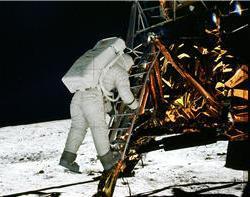 Guess what happened on this day in 1969?
Guess what happened on this day in 1969?
Anyone?
Only the most significant human achievement ever. Yeah, for the first time we stepped onto another planet. Just to prove we could. We may just be the only organisms in this universe who have stepped onto a planet we weren’t born on. And we did it with equipment so primitive by today’s standards, they would make your pocket calculator look like Watson. And we made it back in one piece. In fact, we went to the Moon six times, and never lost a man doing it. No single technological endeavor has come close to matching this, even forty-seven years later.
So… why don’t we care?
Why aren’t we holding up this standard and rallying around it? Why aren’t we cheering leaders who say, “If we could do that back then… imagine the miracles we could do today”?
Why aren’t we standing together, warm in the knowledge that when we work together, we can accomplish the impossible… and even things that are very, very hard?
Why aren’t we lionizing NASA, the original competence porn organization, for their ability to bring men and women from every walk of life together into a cohesive team… a team that showed no sign of segregating itself into groups when it came time to celebrate their accomplishments (or deal with their failures)?
Why aren’t we leading the charge of making July 20 an international holiday for all of Mankind?
Why, instead, are we tolerating the conversion of the party of Lincoln and FDR into a bunch of racist, misogynistic rednecks, the relentless attacks of brother on brother, the dumbing down of the American educational system, the mindless bread and circuses distracting us from the work that needs to be done to preserve our planet and shore up the infrastructure we, ourselves, built, now crumbling before our eyes?
Because the United States of America cares nothing about the achievements (and mistakes) of the past, and has given up on the future. It refuses to invest in our posterity or put money away for rainy days. Its greatest accomplishments mean nothing to the people on the street, the struggling family, the fat businessperson or the corrupt politician.
America has lost sight of the fact that it was once a country that other countries looked up to for good reason. It’s lost its pride of accomplishment and vision to the future. It…
…
Oh, what the hell. Go back to watching American Idol.
…
And by the way: July 20 isn’t just noted for a Moon landing.
Yeah, it’s only the first unmanned landing on Mars. What the heck.


July 13, 2016
Gotta catch ’em all! (Consumers, that is.)
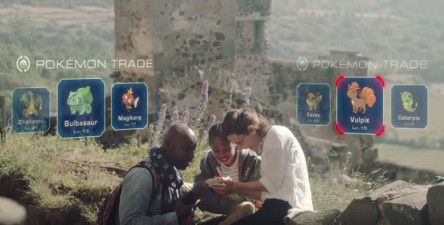 The other day, a girl I regularly see on my commuter train asked me if I was playing Pokemon Go… and when I said I wasn’t, she whipped up her phone and started gushing about how much fun it was, how many Pokemons she’d caught, how the game worked, which Pokemons are which and what they can do, etc, etc. And three others aboard immediately joined the conversation and started sharing.
The other day, a girl I regularly see on my commuter train asked me if I was playing Pokemon Go… and when I said I wasn’t, she whipped up her phone and started gushing about how much fun it was, how many Pokemons she’d caught, how the game worked, which Pokemons are which and what they can do, etc, etc. And three others aboard immediately joined the conversation and started sharing.
I wouldn’t poke fun at them for playing the game—hey, I sat through a late-night marathon of Dangermouse once—but part of me did think it was funny when she told me she’d never regularly watched the original TV shows, or the movie. Others said the same thing. So it clearly isn’t nostalgia that’s drawing people of every age into this game. What’s going on?
 Pundits (oh! that word) are saying that this is only the first step of creating an augmented reality all around us, that we’ll be able to tap into wherever we are. The phone screen overlays the characters onto your landscape, in real-time, so you can search for and catch characters. What advertisers, marketers and producers are hoping is that eventually you’ll use your phone as a window into that virtual reality to find products and services, see which local restaurant has the best sushi, have passing cars point you to the dealership that sold them, listen to your conversation and tell you which bar is playing the Leeds match, etc, ad nauseam.
Pundits (oh! that word) are saying that this is only the first step of creating an augmented reality all around us, that we’ll be able to tap into wherever we are. The phone screen overlays the characters onto your landscape, in real-time, so you can search for and catch characters. What advertisers, marketers and producers are hoping is that eventually you’ll use your phone as a window into that virtual reality to find products and services, see which local restaurant has the best sushi, have passing cars point you to the dealership that sold them, listen to your conversation and tell you which bar is playing the Leeds match, etc, ad nauseam.
But—naturally—that’s not all. The game also taps into your data, collecting info on where you are, where you’re going, who you’re seeing, what you’re buying and how you’re doing it. If you sign into the game using your Google account, the game collects all of your friends’ email addresses. At which point, they can not only send marketing emails directly to you, but keep track of your friends and email them too.
And speaking of data… that game uses a lot of it. Expect your data plan costs to go up, while databases somewhere fill up with more of your comings, goings, buyings, searches and private trivia.
So here’s the thing: When Google Glass came out, people immediately objected to the idea that they were being tracked by some unseen corporation, disseminating their info and contacts, collecting data in order to target marketing at them. What this game is doing is exactly the same thing… but because the game is fun, whayl, shure, you go on ahead and do all that stuff. That makes Pokemon Go the Holy Grail of online marketers and sellers: The thing that makes you want to do all the things they want you to do, whether you want to or not. Or think of it as the bread and circuses being fed to you while your life is being manipulated behind the scenes (and often under your noses). However you think of it, the marketers are getting what they want. You’re getting a game that won’t give you anything if you win, but will always find new ways of parting you from your cash.
And if those (oh!) pundits are right, this will be the first salvo in getting the rest of us into that augmented reality. All it will take, apparently, is something that tickles our fancy just enough to cause us to immerse ourselves in it. Who knows what the next such app could take the form of… trivia clues leading to great restaurants? Passerby fashion rankings? Singles pinpointers? Maps of celebrity sightings and visitations? Simulated X-Ray vision of peoples’ underwear? Floating icons showing peoples’ most intimate (and badly-kept) secrets?
Whatever it is, expect it to be pitched at you sometime soon; and if the marketers know what they’re doing, eventually they’ll catch us all.


June 26, 2016
How to Dismantle a Fandom
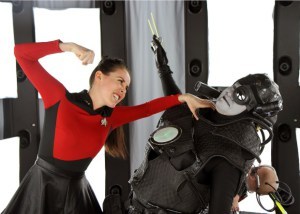
“Guidelines? I gotcher guidelines RIGHT HERE!”
Paramount and CBS, after recently creating a fandom tempest by okaying, then nixing, the Star Trek fan production “Axanar,” has decided to lay down the law of what’s legal for fans to do in terms of Star Trek productions. And Nick Armstrong of Fort Collins Comic Con has provided a breakdown of the new guidelines that would… okay, I’m not going to do a bad Trek pun here, because this just isn’t that funny.
The commentary, Star Trek: A Case Study In How to Dismantle a Fandom, spells it out for you nicely.
On one hand, it’s hard to blame CBS and Paramount for protecting their property rights. And many of the guidelines spelled out in their document seem pretty reasonable… or, at least, in keeping with existing guidelines for other licensed properties. On the other hand, P/CBS is well aware that Star Trek fandom is not only about the most significant fandom there has ever been for any television show, but it is directly responsible for the success of the shows and movies, and has been a significant cash cow for P/CBS through merchandising, going all the way back to 196-frikkin’-8.
So the guidelines that severely restrict fan productions to 30-minute maximum lengths, no use of established characters from the TV shows or movies, no costumes other than officially-licensed-and-purchased costumes, no professional actors, no paying cast or crew (and none of them can ever have been part of a P/CBS Star Trek production), and productions must be PC and rated G… well, pretty much skewers any effort to make a decent Star Trek fan production. In fact, about all you’re left with is the equivalent of those mini-productions you see between the movies on The Disney Channel. It’s pretty much a slap in the face to anyone who’d like to emulate their favorite characters and the vast fictional universe that is Star Trek.
But like I said: P/CBS is fully entitled to do this (well, actually the part about restricting cast and crew to non-pros who’ve never worked a Star Trek production may be anti-labor and subject to further legal action). Trek’s fans have been so notified. And I think their reaction ought to be:
Fine.
Okay, so many people love Star Trek. Many people can enjoy the content P/CBS produces. But hey, fans: If you want to make fan films and such, give serious thought to doing something other than Star Trek. Make your own vehicle. Make it a lot like Star Trek… slightly like Star Trek… nothing like Star Trek… whatever. Be original.
And why not? Star Trek is fifty years old, guys. It’s built on ideas, concepts and science that was all the rage back in 1966. But today, it’s about as relevant as Buck Rogers was when Star Trek came out… think about that. Star Trek was great… for its day. But today, 50 years later, we can do better.
I, myself, did this. When I considered writing a series based on the Trek universe, I realized quickly that there was no reason I couldn’t create my own universe, one that followed rules more in keeping with what we’d learned about science and space in the ensuing decades. And the best part was, my series would be all mine… so no one, including Paramount and CBS, could tell me what to do with it. I wrote three books… sold a few… and never had to worry about anyone showing up at my door demanding a piece of the action. (Yeah, okay, but I felt like that one was justified.)
So let P/CBS have its toy and do whatever they want with it. But remember: You can create your own toys… and they can be better than Star Trek, just because they’re new and up-to-date. Exercise your originality, stretch your creativity. Make your own final frontier. Go for it.


June 22, 2016
And so it ends.
 One of the best serious science fiction shows to ever grace a television screen has aired its last episode on CBS. Team Machine, and their war on the evildoers who would misuse Artificial Intelligence, is done. (There be no spoilers ahead.)
One of the best serious science fiction shows to ever grace a television screen has aired its last episode on CBS. Team Machine, and their war on the evildoers who would misuse Artificial Intelligence, is done. (There be no spoilers ahead.)
From the beginning, I have never stopped praising Person of Interest for its ability to present a world “5 minutes into the future,” where a genius who creates an A.I. (known as The Machine) to help protect ordinary people inadvertently ignites government conspiracies, assassinations, a competing A.I. by would-be world rulers and a possible world-wide doomsday scenario.
And that was by no means all. Person of Interests‘ characters—fondly referred to by the media and fans as Team Machine—were rare in their well-rounded and fleshed out backstories, and played by a superb team of actors. The writing, even mired in its first seasons in the usual threat-of-the-week morass of episodic television, nonetheless brought the science of computers, communications and the digital age to the forefront, kept them there, and never felt like it was making stuff up out of whole cloth… a rare accomplishment for TV science fiction. (Want another example of those rare gems? Try Orphan Black. You have been advised.)
Person of Interest was thoughtful, thrilling, tense, philosophical, funny, sexy and tender. It’s been one of the few bright spots of the last 5 years of television. And now that it’s over, I’m going to miss it terribly.
But is it truly over?
There are discussions of bringing the show to Netflix or some other venue. A few episodes back we were re-introduced to people Team Machine had helped over the years, and who had been contacted by the Machine to help the Team during a dangerous mission. It was clearly suggested that “murders don’t only happen in New York,” and the Machine may have dispatched people to help others in other places. How many people? How many have they saved? No one knows… but that sounds like a great spin-off series to me.
And some think Person of Interest should spawn a movie… maybe something along the lines of many people of various disciplines being contacted by The Machine and brought together to deal with some Mission: Impossible-type problem and save the world. Hey, I’d actually go to a theater to see that.
Well, we can dream. And we can also cherish the last five seasons of Person of Interest, the series that showed modern audiences how TV science fiction is done.
Oh, yeah: How could I forget?
Good boy, Bear. Neem een pauze.


June 16, 2016
Stirling engine to take hybrids to 100MPG
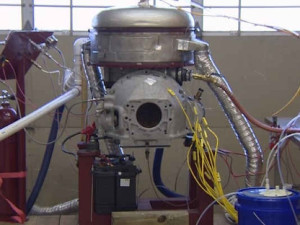 In the “What Took You So Frikkin’ Long?” department:
In the “What Took You So Frikkin’ Long?” department:
Suppose the Stirling steam engine design had been a close second to the steam-driven engines that became industry standards at the beginning of the 1900s? Suppose NASA had experimented with the Stirling engine in the 1980s, and had even developed a hybrid car with it, capable of running at 54MPG just when new cars were averaging 28MPG at best?
Now suppose someone had obtained the NASA Stirling-Electric hybrid design, updated it with modern parts and equipment, and had doubled its range to 100MPG?
Josh “Mac” MacDowell of San Antonio Texas had a brilliant idea. He took a Stirling engine, a type of engine developed 200 years ago, and added some 21st-century technology to it. The result is a hybrid electric car so efficient that you never have to stop to recharge, reports Houston’s KHOU11.
Are you imagining a car that can drive cross-country on 40 gallons of gasoline? MacDowell says he’ll do exactly that, as a demonstration of the patented technology, in about 6 months. And in fact, that gas could potentially be substituted for any fuel that will burn in a chamber, because the stirling engine is only in the car to generate electricity to keep the batteries charged. While the car runs 100% on the batteries, the stirling engine runs at maximum efficiency all the time to create its incredibly low fuel figures.
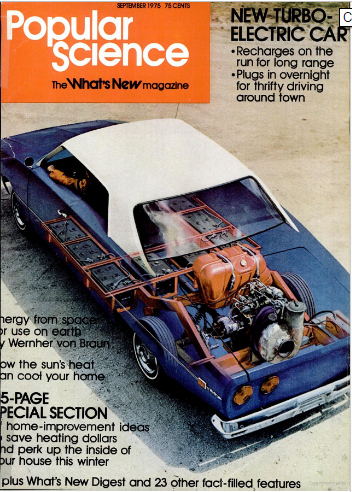 This is a variation on a number of hybrid concepts going back to the 1970s, mostly designed around a car driven exclusively by electric motors, with a smaller fuel-burning engine aboard to recharge the batteries. But most of those 70s design concepts vanished as the auto industry fought to kill any potential game-changing technology that would kill their profits (and those of the oil industry). Today a few hybrids use this configuration, though others drive primarily on gas engines and use electric motors to augment range. But no existing car (in a standard configuration) is capable of a cross-country run on 40 gallons of gas.
This is a variation on a number of hybrid concepts going back to the 1970s, mostly designed around a car driven exclusively by electric motors, with a smaller fuel-burning engine aboard to recharge the batteries. But most of those 70s design concepts vanished as the auto industry fought to kill any potential game-changing technology that would kill their profits (and those of the oil industry). Today a few hybrids use this configuration, though others drive primarily on gas engines and use electric motors to augment range. But no existing car (in a standard configuration) is capable of a cross-country run on 40 gallons of gas.
MacDowell believes this will be the hybrid configuration of the future, and I tend to agree; the alternative of charging stations for electric cars is too slow, in charging and in being installed nationwide, to make electric cars that typically go only 100-200 miles on a charge attractive to drivers anytime soon. Once proven, MacDowell’s design could not only be fit into existing new car designs, but retrofitted into cars already on the road, improving everyone’s range and mileage and cleaning our air.
IF—I say—if he can overcome the resistance of an existing auto industry that has managed to quell every game-changing drive technology since 1970. Maybe Elon Musk will return his calls…


June 12, 2016
Revisiting “Contact”
 Casey Cipriani of Bustle wrote an article a month back that singles out the Robert Zemekis film Contact as “The Forgotten ’90s Sci-Fi Film You Need To Revisit“… and I’m in wholehearted agreement with her.
Casey Cipriani of Bustle wrote an article a month back that singles out the Robert Zemekis film Contact as “The Forgotten ’90s Sci-Fi Film You Need To Revisit“… and I’m in wholehearted agreement with her.
One of the chief reasons for Cipriani’s praise is that Jodie Foster is the lead of the movie, and not just a female-in-a-male-lead role (Cipriani has a distinct feminist leaning, and so has a strong appreciation for good female leads and zero tolerance for gender-swapping). Not that that isn’t significant, but she also points out what I consider the real value of Contact: That it’s one of the very few science fiction movies these days that has a story beyond explosions, crazy stunts and pithy one-liners.
Jodie Foster, speaking at the Cannes Film Festival, stated of her new film Money Monsters that in the present day “I don’t think it’s possible to make those movies financed by a major studio.” She was referring to intelligent movies, movies that want the audience to really think. And as Cipriani points out, the same can be said for science fiction movies: Sadly, the Hollywood Blockbuster Machine sees no value to the smaller, more modest, more intelligent movies, science fiction or otherwise; it’s become fully committed to pandering to the largest common denominator, those who cheer at explosions and boo at every smirking villain.
Contact was not that kind of movie, or course: It’s one of the rare highly intelligent, high-quality science fiction productions that stand on a very small podium with movies like 2001: A Space Odyssey, Solaris, The Andromeda Strain, Jurassic Park and Blade Runner. Like the others mentioned, it is written by a highly-acclaimed author, Carl Sagan; and like the other movies, the producers and director took pains to stay true to the original work.
 The result was a textbook example of what real science fiction is supposed to be about, as opposed to the space operas of movies like Star Wars or the cliché-filled action adventure romps of The Fifth Element. In an age of a population losing its appreciation for the wonders of science—and who have become too jaded or future-shocked to have interest in the tools that could give us a better world—Contact presents a story with deep scientific, social and philosophical connotations, few plug-and-play character stereotypes, and a sense of “this could happen tomorrow” realism that is rare in modern big-budget science fiction.
The result was a textbook example of what real science fiction is supposed to be about, as opposed to the space operas of movies like Star Wars or the cliché-filled action adventure romps of The Fifth Element. In an age of a population losing its appreciation for the wonders of science—and who have become too jaded or future-shocked to have interest in the tools that could give us a better world—Contact presents a story with deep scientific, social and philosophical connotations, few plug-and-play character stereotypes, and a sense of “this could happen tomorrow” realism that is rare in modern big-budget science fiction.
And let’s not short-change the idea of a female lead: Cipriani is right in that movies in general, and science fiction in particular, are largely bereft of female leads or significant female characters in a male-oriented market; much of the science fiction audience in particular still seems to chafe at the idea of a non-sex-object in-charge woman—or, at least, that’s what big budget science fiction producers clearly think. As science fiction is supposed to represent a better world, it should be presenting us with more significant female characters to match the significant female roles in modern society. Even Contact could have done better in female representation… quickly, what other females in significant roles were in it?
Answer: Exactly one—Angela Bassett (who isn’t even listed as one of the main characters in IMDb). To be fair, there aren’t many SF movies that do better, especially in the most serious picks… it’s a pretty damning state. Maybe if SF movies could create more stories around strong and significant female characters, we’d see more evidence that science fiction isn’t just for nerds with penises. In that sense, Contact is an inspiration for SF lovers of any sex.
If you haven’t seen Contact, go find a copy soon. If you have seen the movie, recommend it to someone.



